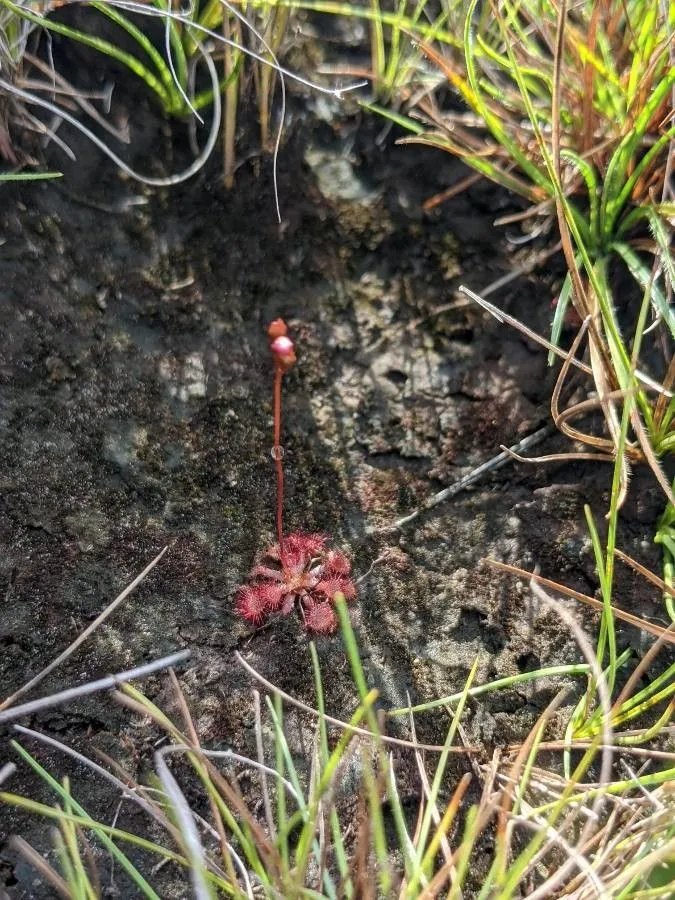
Author: Poir.
Bibliography: J.B.A.M.de Lamarck, Encycl. 6: 299 (1804)
Year: 1804
Status: accepted
Rank: species
Genus: Drosera
Vegetable: False
Observations: Trop. & Subtrop. America
The Pink Sundew, known scientifically as Drosera capillaris, is a fascinating and delicate carnivorous plant belonging to the Droseraceae family. First documented by J.B.A.M. de Lamarck in 1804, this species was later detailed by Poir., encapsulating the intriguing botany of this diminutive yet captivating plant.
Hailing from tropical and subtropical regions of the Americas, the Pink Sundew exhibits a unique adaptation to its environment. These plants commonly thrive in moist, sandy, or boggy areas where nutrients in the soil are often scarce. To compensate, Drosera capillaris has evolved to capture and digest insects, supplementing its nutrient intake from a typically nitrogen-poor substrate.
The Pink Sundew is typically characterized by its small, reddish to pink, and sometimes even greenish leaves, which are densely covered in mucilage-secreting glands. These glands are not just for show; they function as both a trap and a digestive mechanism. When an unsuspecting insect lands on the dewy leaf, it becomes ensnared by the sticky secretion. The plant then slowly envelops its prey and secretes digestive enzymes, breaking down the insect and absorbing the resultant nutrients.
Drosera capillaris displays a rosette growth habit, with leaves that often form a neat, ground-hugging circle. The photogenic beauty of this plant is enhanced by its tiny, glandular hairs that glisten like morning dew, earning it the common name “sundew.” When the light catches these dewy droplets just right, the effect is nothing short of enchanting—a delicate sparkle that belies the plant’s lethal efficiency.
Flowering is another remarkable aspect of the Pink Sundew’s lifecycle. It produces small, typically pink flowers on erect stalks, which rise above the rosette of leaves. This positioning ensures that pollinators can access the flowers without becoming inadvertent prey. This evolutionary mechanism is essential for the continuation of the species, ensuring that potential pollinators remain unharmed by the plant’s carnivorous traps.
Cultivating Drosera capillaris can be a rewarding experience for enthusiasts, provided its specific growing conditions are met. It prefers high humidity and plenty of light, mimicking its natural habitat. A substrate of acidic, nutrient-poor media such as a mixture of sphagnum moss and sand is ideal. Ensuring the soil is consistently wet, and providing ample light, are key elements in growing a healthy Pink Sundew.
In summary, the Pink Sundew, Drosera capillaris, is a testament to the marvels of plant adaptation and evolution. Its captivating appearance and unique lifestyle make it a subject of interest not just for botanists but for anyone intrigued by the wonders of our natural world.
Eng: pink sundew
En: Pink sundew
Zh: 絨毛毛氈苔, 绒毛茅膏菜
Zh-tw: 絨毛毛氈苔
Zh-hant: 絨毛毛氈苔
© copyright of the Board of Trustees of the Royal Botanic Gardens, Kew.
© copyright of the Board of Trustees of the Royal Botanic Gardens, Kew.
© copyright of the Board of Trustees of the Royal Botanic Gardens, Kew.
Taken Nov 25, 2021 by Bogdan Miloradovic (cc-by-sa)
Taken Mar 15, 2020 by Diaz jimmy (cc-by-sa)
Taken Dec 23, 2021 by Kornél Regius (cc-by-sa)
Taken Dec 28, 2020 by FERREIRA DIEGO CÉSAR (cc-by-sa)
Taken Jul 8, 2020 by Canchis Coppola Luciana (cc-by-sa)
Taken Jun 10, 2009 by EOL − Barry Rice (cc-by-nc-sa)
Taken Nov 19, 2016 by Tela Botanica − Pauline GUILLAUMEAU (cc-by-sa)
Taken Nov 19, 2016 by Tela Botanica − Pauline GUILLAUMEAU (cc-by-sa)
Taken Jun 10, 2009 by EOL − Barry Rice (cc-by-nc-sa)
Taken Oct 1, 2021 by Denis Bastianelli (cc-by-sa)
Taken Apr 20, 2006 by EOL − Barry Rice (cc-by-nc-sa)
Taken Jun 23, 2019 by john vantighem (cc-by-sa)
Taken Jan 26, 2013 by EOL − Javier Alejandro (cc-by-nc)
Taken Feb 21, 2013 by EOL − Bob Peterson (cc-by-sa)
Taken Jan 26, 2013 by EOL − Javier Alejandro (cc-by-nc)
Taken Jun 10, 2009 by EOL − Barry Rice (cc-by-nc-sa)
Taken Jun 15, 2010 by EOL − Barry Rice (cc-by-nc-sa)
Growth habit>: Forb/herb
Family: Myrtaceae Author: (F.Muell.) K.D.Hill & L.A.S.Johnson Bibliography: Telopea 6: 402 (1995) Year: 1995 Status:…
Family: Rubiaceae Author: Pierre ex A.Froehner Bibliography: Notizbl. Bot. Gart. Berlin-Dahlem 1: 237 (1897) Year:…
Family: Sapindaceae Author: Koidz. Bibliography: J. Coll. Sci. Imp. Univ. Tokyo 32(1): 38 (1911) Year:…
Family: Asteraceae Author: A.Gray Bibliography: Pacif. Railr. Rep.: 107 (1857) Year: 1857 Status: accepted Rank:…
Family: Fabaceae Author: Medik. Bibliography: Vorles. Churpfälz. Phys.-Ökon. Ges. 2: 398 (1787) Year: 1787 Status:…
Family: Aspleniaceae Author: (Cav.) Alston Bibliography: Bull. Misc. Inform. Kew 1932: 309 (1932) Year: 1932…